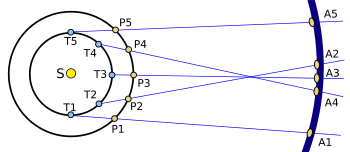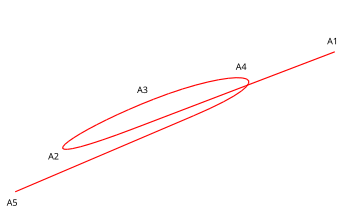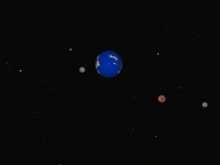straight and declining
In astronomy, objects that follow the main direction of rotation in a rotating system are referred to as straight or prograd (from the Latin pro 'for', 'before', 'forwards' and gradus 'step'). Objects rotating or rotating in the opposite direction are referred to as retrograde or retrograde (lat. Retro 'back', 'backwards').
The terms are used for orbiting star systems , planets , asteroids and comets , as well as for satellites in their orbit . An object with a retrograde orbit is characterized by an orbital inclination between 90 ° and 270 ° to its central body, an object with retrograde rotation by an axis inclination of 90 ° to 270 ° to its orbit.
There are also artificial satellites in space travel that orbit the earth in retrograde orbits against its sense of rotation.
Meaning in the solar system
In the solar system , objects that rotate counterclockwise or orbit their central body when viewed from the direction of the north pole of the ecliptic are considered to be right .
As a result of the formation of the solar system, all planets, Pluto and the asteroid belt move in a right-hand orbit. Most of the larger bodies in the solar system also rotate in right directions.
Some known retrograde natural celestial bodies
Retrograde orbit
-
Triton (Neptune I), orbit inclination: 157 °
Largest retrograde moon in the solar system. It is believed that this moon is an object trapped by gravity . - Various Jupiter and Saturn moons , e.g. B .:
- The Halley's Comet
- The exoplanet HD209458b
- Various small planets like (20461) Dioretsa , 2008 KV 42 , (471325) 2011 KT19 , (342842) 2008 YB 3 , (468861) 2013 LU 28 , 2011 MM 4 , especially in the outer solar system
- Various asteroids like (514107) Kaʻepaokaʻawela
Retrograde rotation
- Venus , axis inclination: 177 °
-
Uranus , axis inclination: 98 °
Largest retrograde object in the solar system, but its retrograde character is hardly recognizable due to the almost right-angled axis inclination. - Pluto , axis inclination: 123 °
Apparent right-hand and retrograde movement
Objects of the solar system are said to be right-handed if their orbit along the ecliptic, viewed from the direction of the north pole of the ecliptic, is counterclockwise. When going clockwise, it is called retrograde . Since their orbital times, according to Kepler's third law, are different from the orbital time of the earth, changes in the apparent direction of rotation (the position vector related to the earth) occur during the overtaking maneuvers, for example the characteristic planetary loops when the outer planets are in opposition . The explanation of this change was important for the development of the geocentric and the heliocentric worldview. (→ epicyclic theory )

Movement of the inner celestial body past the outer celestial body, plan view of the system
T1–5: points of the inner orbit P1–5: simultaneous points of the outer orbit A1–5: projection onto the apparent celestial vault The points in time are in the range of half the period of rotation of the inner body. |

Appearance as a celestial sight , topocentric point of view, star-fixed image:
Movement of the celestial body as a " wandering star " against the fixed stars: Since the starry sky moves westward during the night (here on the right), the movement of the celestial body appears to be retrograde (to the left). The transverse movement in the loop is due to the fact that the path planes are generally not exactly the same: This also changes the third coordinate of the points. |
Web links
Individual evidence
- ↑ Canada France Ecliptic Plane Survey: Discovery of the retrograde trans-neptunian object 2008 KV42. In: cfeps.net . 2008 ( cfeps.net ).
- Jump up ↑ Ying-TungChen, Hsing Wen Lin, Matthew J Holman, Matthew J Payne et al .: Discovery of A New Retrograde Trans-Neptunian Object: Hint of A Common Orbital Plane for Low Semi-Major Axis, High Inclination TNOs and Centaurs . In: The Astrophysical Journal. 827: L24, 2016, arxiv : 1608.01808 [astro-ph] .
- ↑ C. de la Fuente Marcos, R. de la Fuente Marcos .: Large retrograde Centaurs: visitors from the Oort cloud? In: Astrophysics and Space Science . No. 352/2 , 2014, p. 409-419 , arxiv : 1406.1450 .
